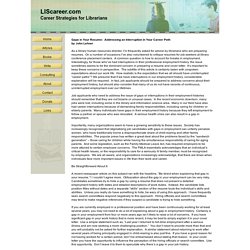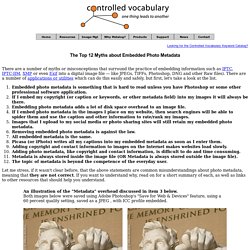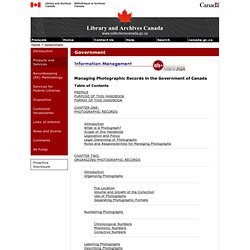

Career Strategies for Librarians. Gaps in Your Resume: Addressing an Interruption in Your Career Pathby John Lehner As a library human resources director, I’m frequently asked for advice by librarians who are preparing resumes.

On a number of occasions I’ve also volunteered to critique resumes for job-seekers at library conference placement centers. A common question is how to account for breaks in employment. Interestingly, for those who’ve had interruptions in their professional employment history, the issue sometimes seems to be the dominant concern in preparing a resume and cover letter. It’s important to keep these concerns in perspective. Job applicants who need to address the issue of gaps or interruptions in their employment histories should remember that they are not bizarre or unusual cases. Importantly, many organizations seem to have a growing sensitivity to these issues. Be Straightforward About It An Interesting Example Some Key Points Maintain your overall perspective in the job search.
Notes: LibraryToolshed. Info Career Trends » Vita vs. Resume: Get Unstuck through Knowing the Difference. The I Need a Library Job eResource center! A community of information professionals working together to help you find a job! All Training Resources. The Top 12 Metadata Myths: ControlledVocabulary.com. The Top 12 Myths about Embedded Photo Metadata There are a number of myths or misconceptions that surround the practice of embedding information such as IPTC, IPTC-IIM, XMP or even Exif into a digital image file — like JPEGs, TIFFs, Photoshop, DNG and other Raw files).

There are a number of applications or utilities which can do this easily and safely, but first, let's take a look at the list. Embedded photo metadata is something that is hard to read unless you have Photoshop or some other professional software application. If I embed my copyright (or caption or keywords, or other metadata field) into my images it will always be there. Embedding photo metadata adds a lot of disk space overhead to an image file. Let me stress, if it wasn't clear before, that the above statements are common misunderstandings about photo metadata, meaning that they are not correct. 1. 2. 3. 4. 5. 6. 7. 8.
Tips for library job applicants in a tight market. Another semester of teaching at San Jose State’s SLIS program has ended.

Many of my students are graduating and others are starting to think about applying for jobs so they’ll have one when they do graduate. For so many of them, the job search is going to be a struggle. It wasn’t an easy job market when I was applying more than five years ago (took me 9 months of looking to get my first job), and it’s only gotten worse in the past couple of years. Managing Photographic Records in the Government of Canada - Tools - Government. Table of Contents IntroductionWhat is a Photograph?

Scope of this HandbookLegislation and PolicyLegal Ownership of PhotographsRoles and Responsibilities for Managing Photographs IntroductionOrganizing Photographs File LocationVolume and Growth of the CollectionUse of PhotographsSeparating Photographic Formats Numbering Photographs Chronological NumbersMnemonic NumbersCollective Numbers Labelling PhotographsDescribing Photographs Descriptive Standards and PracticesItem-level DescriptionCollective-level Description Related Documentation Subject Files and IndexesRetrieval Systems Card IndexCaption SheetsAutomated RetrievalMicroformVideotape, Videodisc and Digital Imaging IntroductionHandling GuidelinesStoring Photographs.
Preserving Time Project - Home. Library Fact Sheets. The ALA Library receives inquiries from librarians across the country and around the world, as well as from the general public, on a wide variety of library topics.

We have prepared fact sheets on the most asked-about topics, as noted below. If you don't see your topic, or if you need more information than is provided on the fact sheets, feel free to contact the ALA Library Reference Desk by telephone: 800-545-2433, extension 2153; fax: 312-280-3255; e-mail: library@ala.org; or regular mail: ALA Library, American Library Association, 50 East Huron Street, Chicago, IL 60611-2795. Resources for Frequently Asked Questions About Libraries List of Library Fact Sheets ALA Library Fact Sheet 1 - Number of Libraries in the United States Number of libraries in the U.S. broken down by type of library. The Nation's Largest Libraries: A Listing By Volumes Held. This fact sheet lists the top 100 largest libraries in the United States by volumes held.

For lists of the largest public libraries only, see ALA Library Fact Sheet 13 - The Nation's Largest Public Libraries: Top 25 Rankings, which lists the top 25 public libraries in the United States by population served, by library collection, by circulation, and by library visits. See below for definitions of "volume" for both public libraries and academic (college and university) libraries. Sources.
Preservation & Conservation (non-digital) LIS Humour, Blogs, Etc. Reference Resources. Expert Searching. Associations, Groups, etc. Digital Preservation. Metadata, Cataloguing, and Controlled Vocabulary. Bodycard 0248.